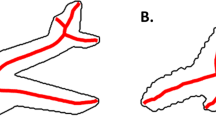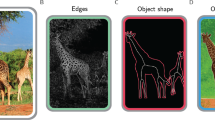Abstract
The human visual system analyzes shapes and objects in a series of stages in which stimulus features of increasing complexity are extracted and analyzed. The first stages use simple local features, and the image is subsequently represented in terms of larger and more complex features. These include features of intermediate complexity and partial object views. The nature and use of these higher-order representations remains an open question in the study of visual processing by the primate cortex. Here we show that intermediate complexity (IC) features are optimal for the basic visual task of classification. Moderately complex features are more informative for classification than very simple or very complex ones, and so they emerge naturally by the simple coding principle of information maximization with respect to a class of images. Our findings suggest a specific role for IC features in visual processing and a principle for their extraction.
This is a preview of subscription content, access via your institution
Access options
Subscribe to this journal
Receive 12 print issues and online access
$209.00 per year
only $17.42 per issue
Buy this article
- Purchase on Springer Link
- Instant access to full article PDF
Prices may be subject to local taxes which are calculated during checkout





Similar content being viewed by others
References
Barlow, H.B. & Foldiak, P. in The Computing Neuron (eds. Durbin, R., Miall, C. and Mitchison, G.) 54–72 (Addison-Wesley, Reading, Massachusetts, 1989).
Atick, J.J. & Redlich, N.A. What does the retina know about natural scenes? Neural Comput. 4, 196–210 (1992).
Bell, A.J. & Sejnowski, T.J. The 'independent components' of natural scenes are edge filters. Vision Res. 37, 3327–3338 (1997).
Field, D.J. What is the goal of sensory coding? Neural Comput. 6, 559–601 (1994).
Olshausen, B. & Field, D.J. Emergence of simple-cell receptive field properties by learning a sparse code for natural images. Nature 381, 607–609 (1996).
Vinje, W.E. & Gallant, J.L. Sparse coding and decorrelation in primary visual cortex during natural vision. Science 287, 1273–1276 (2000).
Rolls, E.T. Neural organization of higher visual functions. Curr. Opin. Neurobiol. 1, 275–278 (1991).
Fujita, I., Tanaka, K., Ito, M. & Cheng, K. Columns for visual features of objects in monkey inferotemporal cortex. Nature 360, 343–346 (1992).
Gallant, J.L., Braun, J. & Van Essen, D.C. Selectivity for polar, hyperbolic, and cartesian gratings in macaque visual cortex. Science 259, 100–103 (1993).
Tanaka, K. Neuronal mechanisms of object recognition. Science 262, 685–688 (1993).
Logothetis, N.K., Pauls, J., Bulthoff, H.H. & Poggio, T. Shape representation in the inferior temporal cortex of monkeys. Curr. Biol. 5, 552–563 (1995).
Wiskott, L., Fellous, J.M., Krüger, N., & von der Malsburg, C. Face recognition by elastic bunch graph matching. IEEE Trans. Pattern Anal. Mach. Intell. 19, 775–779 (1997).
Turk, M. & Pentland, A. Eigenfaces for recognition. J. Cogn. Neurosci. 3, 71–86 (1990).
Belhumeur, P.N., Hespanha, J.P. & Kriegman, D.J. Eigenfaces versus fisherfaces: recognition using class specific linear projection. IEEE Trans. Pattern Anal. Mach. Intell. 19, 711–720 (1997).
Ballard, D.H. & Brown, C.M. Computer Vision (Prentice-Hall, Inglewood Cliffs, New Jersey, 1982).
DeValois, R.L., Albrecht, D.G. & Thorell, L.G. Spatial frequency selectivity of cells in the macaque visual cortex. Vision Res. 22, 545–559 (1982).
Brunelli, R. & Poggio, T. Face recognition: features versus templates. IEEE Trans. Pattern Anal. Mach. Intell. 15, 1042–1052 (1993).
Lee, D.D. & Seung, H.S. Learning the parts of objects by non-negative matrix factorization. Nature 401, 788–791 (1999).
Rosch, E., Mervis, C.B., Gray, W.D., Johnson, D.M. & Boyes-Braem, P. Basic objects in natural categories. Cognit. Psychol. 8, 382–439 (1976).
Riesenhuber, M. & Poggio, T. Hierarchical models of object recognition in cortex. Nat. Neurosci. 2, 1019–1025 (1999).
Yang, M.H., Kriegman, D.J. & Ahuja, N. Detecting faces in images: a survey. IEEE Trans. Pattern Anal. Mach. Intell. 24, 34–58 (2002).
Mel, B.W. SEEMORE: combining color, shape, and texture histogramming in a neurally inspired approach to visual object recognition. Neural Comput. 9, 777–804 (1997).
Ullman, S. & Soloviev, S. Computation of pattern invariance in brain-like structures. Neural Net. 12, 1021–1036 (1999).
Vogels, R. Effects of image scrambling on inferior temporal cortical responses. Neuroreport 10, 1811–1816 (1999).
Grill-Spector, K., Kushnier, T., Hendler, T., Edelman, S., Itzchak, Y. & Malach, R. A sequence of object-processing stages revealed by fMRI in human occipital lobe. Hum. Brain Mapp. 6, 316–328 (1998).
Logothetis, N.K. & Sheinberg, D.L. Visual object recognition. Annu. Rev. Neurosci. 19, 577–621 (1996).
Bhat, D. & Nayar, K.S., Ordinal measures for image correspondence. IEEE Trans. Pattern Anal. Mach. Intell. 20, 415–423 (1998).
Friedman, N., Geiger, D. & Goldszmidt, M. Bayesian network classifiers. Mach. Learn. 29, 131–163 (1997).
Acknowledgements
We thank J. Golberger, M. Bar and N. Rubin for helpful discussions. Supported by Grant 99-28 CN-QUA.05 from the James S. McDonnell Foundation and by the Moross Laboratory at the Weizmann Institute. Face images for testing were in part from the to Carnegie Mellon University (CMU) face images database http://www.cs.cmu.edu/~har/faces.html#upright.
Author information
Authors and Affiliations
Corresponding author
Ethics declarations
Competing interests
The authors declare no competing financial interests.
Rights and permissions
About this article
Cite this article
Ullman, S., Vidal-Naquet, M. & Sali, E. Visual features of intermediate complexity and their use in classification. Nat Neurosci 5, 682–687 (2002). https://doi.org/10.1038/nn870
Received:
Accepted:
Published:
Issue Date:
DOI: https://doi.org/10.1038/nn870
This article is cited by
-
Adaptive mechanisms facilitate robust performance in noise and in reverberation in an auditory categorization model
Communications Biology (2023)
-
Modularity in Nervous Systems—a Key to Efficient Adaptivity for Deep Reinforcement Learning
Cognitive Computation (2023)
-
Visual complexity of shapes: a hierarchical perceptual learning model
The Visual Computer (2022)
-
Brain-inspired models for visual object recognition: an overview
Artificial Intelligence Review (2022)
-
Visual prototypes in the ventral stream are attuned to complexity and gaze behavior
Nature Communications (2021)



